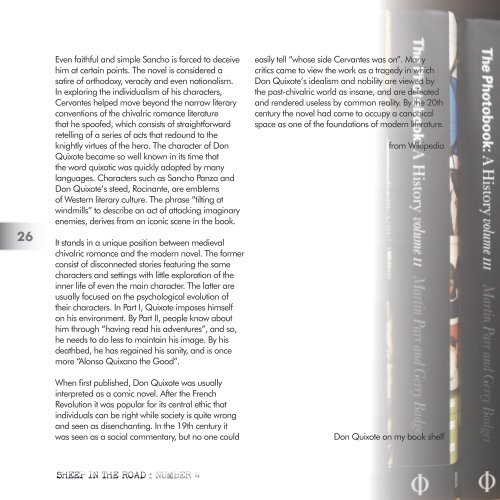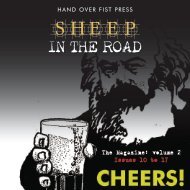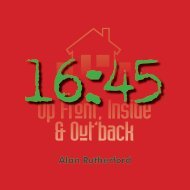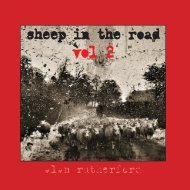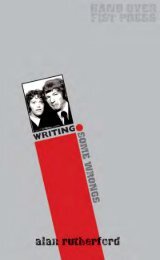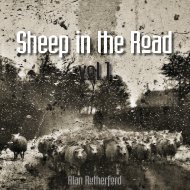- Page 1:
HAND OVER FIST PRESS SHEEP IN THE R
- Page 5 and 6:
This Volume’s CONTENTS ----------
- Page 7 and 8:
ANOTHER OPENING -------------------
- Page 9:
HAND OVER FIST PRESS SHEEP IN THE R
- Page 13 and 14:
The CONTENTS ----------------------
- Page 15 and 16:
OPENING ---------------------------
- Page 18 and 19:
6 SHEEP IN THE ROAD : NUMBER 3
- Page 20 and 21:
8 Hitler’s Nazis built concentrat
- Page 22 and 23:
10 SHEEP IN THE ROAD : NUMBER 3
- Page 24 and 25:
12 especially in Northern Ireland w
- Page 26 and 27:
1914-1918 World War One Allied prop
- Page 28 and 29:
16 But this ideological war about t
- Page 31 and 32:
Meanwhile, the BBC has confirmed th
- Page 33 and 34:
ARMAMENTS MANUFACTURERS MAKE A KILL
- Page 36:
a substantially undiscovered part o
- Page 39 and 40:
OCTOBER 2015 27
- Page 41 and 42:
OPINION ---------------------------
- Page 43:
Books are weapons! Hit a tory with
- Page 46:
34 he had been tucked up nicely in
- Page 50 and 51:
38 .3 “Get up”. A foot pushed h
- Page 52 and 53:
40 SHEEP IN THE ROAD : NUMBER 3
- Page 54 and 55:
42 just to save you two dobbers fro
- Page 56:
.4 Brad McGlaughlin. And I knew his
- Page 60:
So, as social beings inhabiting thi
- Page 63 and 64: OPINION ---------------------------
- Page 65 and 66: Bigger businesses will simply incre
- Page 67: Stars are an important inclusion: t
- Page 70 and 71: 58 sprawling, bike on top of me, un
- Page 72 and 73: 60 SHEEP IN THE ROAD : NUMBER 3
- Page 74 and 75: 62 Ostensibly, Britain went to war
- Page 76 and 77: 64 On the African continent, South
- Page 78 and 79: men) involved in the South West and
- Page 80 and 81: 68 Nowhere in Smuts’ report to th
- Page 82 and 83: This wonderful piece of artwork fou
- Page 84 and 85: 72 SHEEP IN THE ROAD : NUMBER 3
- Page 86 and 87: HAND OVER FIST PRESS 2 0 1 5
- Page 88 and 89: Alan Rutherford 1984
- Page 90 and 91: Alan Rutherford
- Page 92 and 93: 4 Alan Rutherford Don’t let this
- Page 94 and 95: The collective principle asserts th
- Page 96 and 97: 8 services was nowhere near as gene
- Page 98 and 99: hmm... tony still has those skeleto
- Page 100 and 101: Alan Rutherford
- Page 102 and 103: 14 What’s going on here? Part of
- Page 104 and 105: 16 a hint at dickensian times to co
- Page 107 and 108: That’s Why (we don’t comply wit
- Page 110: 22 Among other things they pointed
- Page 116 and 117: FOR THE LOVE OF BOOKS ...
- Page 118 and 119: POETRY ----------------------------
- Page 120 and 121: 32 REVIEW -------------------------
- Page 122 and 123: 34 the good ones, with their dynami
- Page 124: Very good satire on UKIP’s ankle-
- Page 129: BRISTOL ---------------------------
- Page 133: DECEMBER 2015 45
- Page 136 and 137: 48 SHEEP IN THE ROAD : NUMBER 4
- Page 138: 50 SHEEP IN THE ROAD : NUMBER 4
- Page 143 and 144: The LONE WANDERER (30s) handsome-bu
- Page 145 and 146: He closes the seat. And jumps back
- Page 147 and 148: AGITATORS NEEDED NOW! Alan Rutherfo
- Page 149: Lesson What is it child, that pulls
- Page 152: 64 SHEEP IN THE ROAD : NUMBER 4
- Page 155 and 156: DECEMBER 2015 67
- Page 157 and 158: DECEMBER 2015 69
- Page 159 and 160: DECEMBER 2015 71
- Page 161 and 162: REVIEWED --------------------------
- Page 163:
overlooked other guitarist, Paul Ba
- Page 166 and 167:
78 SHEEP IN THE ROAD : NUMBER 4
- Page 168 and 169:
80 SHEEP IN THE ROAD : NUMBER 4
- Page 170 and 171:
HAND OVER FIST PRESS 2 0 1 5
- Page 172 and 173:
‘tis the season to be jolly SHEEP
- Page 174 and 175:
SAY NO TO TORY CUTS!
- Page 176 and 177:
4 SHEEP IN THE ROAD : NUMBER 5
- Page 178 and 179:
unanimously refuse to countenance t
- Page 180 and 181:
‘His blood Has crept through scou
- Page 183 and 184:
IF YOU ARE CONCERNED ABOUT THE WEAT
- Page 186 and 187:
CONSENT? 14 -----------------------
- Page 188 and 189:
16 The question that should have be
- Page 190 and 191:
18 SHEEP IN THE ROAD : NUMBER 5
- Page 192 and 193:
20 SHEEP IN THE ROAD : NUMBER 5
- Page 194 and 195:
excavated red with clay and tailing
- Page 196 and 197:
A DEAD FOX HUNTED BY THE HOUNDS OF
- Page 198 and 199:
26 A perspective from a West Midlan
- Page 200 and 201:
28 political system likes people to
- Page 202 and 203:
30 SHEEP IN THE ROAD : NUMBER 5
- Page 204 and 205:
32 station. Fortunately the desk se
- Page 206 and 207:
dedicated people can change the wor
- Page 208 and 209:
36 During World War 2 the language
- Page 210 and 211:
38 SHEEP IN THE ROAD : NUMBER 5
- Page 212 and 213:
40 SHEEP IN THE ROAD : NUMBER 5
- Page 214 and 215:
42 SHEEP IN THE ROAD : NUMBER 5 UND
- Page 216 and 217:
44 abaft aft amidships anchor aster
- Page 218 and 219:
46 BARCELONA 2005 SHEEP IN THE ROAD
- Page 220 and 221:
48 SHEEP IN THE ROAD : NUMBER 5
- Page 222 and 223:
50 SHEEP IN THE ROAD : NUMBER 5
- Page 224 and 225:
52 SHEEP IN THE ROAD : NUMBER 5
- Page 226 and 227:
54 SHEEP IN THE ROAD : NUMBER 5
- Page 228 and 229:
56 SHEEP IN THE ROAD : NUMBER 5
- Page 230 and 231:
58 SHEEP IN THE ROAD : NUMBER 5
- Page 232 and 233:
60 SHEEP IN THE ROAD : NUMBER 5
- Page 234 and 235:
62 SHEEP IN THE ROAD : NUMBER 5
- Page 236 and 237:
64 SHEEP IN THE ROAD : NUMBER 5
- Page 238 and 239:
HAND OVER FIST PRESS 2 0 1 5
- Page 240 and 241:
Well, I stand up next to a mountain
- Page 243:
OPENING ---------------------------
- Page 247 and 248:
Somehow, online mainly, word spread
- Page 250 and 251:
To have the work collected by galle
- Page 252 and 253:
A refugee, according to the Geneva
- Page 254 and 255:
14 The Situationists were the inspi
- Page 257 and 258:
NEW CLARION PRESS Chris Bessant New
- Page 259 and 260:
JANUARY 2016 19
- Page 261:
I-CAPITALIST BRITAIN EDITED BY N CA
- Page 264 and 265:
24 SHEEP IN THE ROAD : NUMBER 6
- Page 266 and 267:
26 SHEEP IN THE ROAD : NUMBER 6
- Page 268 and 269:
Since the end of World War Two the
- Page 270 and 271:
30 SHEEP IN THE ROAD : NUMBER 6
- Page 272 and 273:
Ali Ismail Abbas, 2003 32 SHEEP IN
- Page 274 and 275:
elow: Robin Brookes, right: Brenda
- Page 276 and 277:
36 SHEEP IN THE ROAD : NUMBER 6
- Page 278 and 279:
38 SHEEP IN THE ROAD : NUMBER 6
- Page 280 and 281:
Being filmed ... and right, Joe Jen
- Page 282 and 283:
42 SHEEP IN THE ROAD : NUMBER 6
- Page 284 and 285:
44 SHEEP IN THE ROAD : NUMBER 6
- Page 286 and 287:
46 She emerged, pulling a tissue fr
- Page 288 and 289:
I woke naked and sweating, my heart
- Page 290:
50 Muffled noises, head throbbing,
- Page 293 and 294:
CHELTENHAM ------------------------
- Page 295:
55 ‘BECAUSE ITS THE RIGHT THING T
- Page 298 and 299:
58 SHEEP IN THE ROAD : NUMBER 6
- Page 300 and 301:
60 The B-52G began its mission from
- Page 302 and 303:
62 Despite the cost and number of p
- Page 305 and 306:
WHITHER --------------- THE WEATHER
- Page 307 and 308:
67 Russian 1906 SATIRICAL magazines
- Page 309 and 310:
JANUARY 2016 69
- Page 311 and 312:
Moving into a section labeled ‘Sp
- Page 313 and 314:
Moving up to the ‘Speaking Out’
- Page 315 and 316:
JANUARY 2016 75
- Page 317 and 318:
WAFFLE ----------------------------
- Page 319 and 320:
SHEEP IN THE ROAD SE EN FEBRUARY 20
- Page 321:
The CONTENTS ----------------------
- Page 324 and 325:
4 New romantic New Labour New World
- Page 326 and 327:
6 SHEEP IN THE ROAD : NUMBER 7
- Page 329 and 330:
REVEALED --------------------------
- Page 331 and 332:
exhibited artwork: Alan Rutherford
- Page 333 and 334:
Max Keith sat surrounded by his dep
- Page 335 and 336:
Siemens took slave labourers during
- Page 337:
Photograph: Auschwitz, May 1944, ph
- Page 341 and 342:
$ £ 21 ¥ € FEBRUARY 2016
- Page 343 and 344:
FEBRUARY 2016 23
- Page 345 and 346:
CARBON COPY -----------------------
- Page 347 and 348:
Professor Cox gives an example of a
- Page 349 and 350:
I was a dam builder Across the rive
- Page 351 and 352:
GIN LANE William Hogarth 1751 One o
- Page 353 and 354:
Tipping was forbidden by law; almos
- Page 355 and 356:
UNTITLED (Chairs) from Zeno Writing
- Page 357:
37 Oh shit! Forgot to remove the ..
- Page 360 and 361:
40 SHEEP IN THE ROAD : NUMBER 7
- Page 362 and 363:
42 SHEEP IN THE ROAD : NUMBER 7 UND
- Page 364 and 365:
44 the bastard is onto us chief ...
- Page 366 and 367:
46 SHEEP IN THE ROAD : NUMBER 7
- Page 368 and 369:
The moon and I, We’re low tonight
- Page 370 and 371:
50 SHEEP IN THE ROAD : NUMBER 7
- Page 372 and 373:
52 had been together in her kaya, a
- Page 374 and 375:
their orders to hide behind and who
- Page 376 and 377:
56 SHEEP IN THE ROAD : NUMBER 7
- Page 378 and 379:
58 by the racial spite of their eld
- Page 380 and 381:
60 SHEEP IN THE ROAD : NUMBER 7
- Page 382 and 383:
HAND OVER FIST PRESS 2 0 1 6
- Page 384 and 385:
SHEEP IN THE ROAD : NUMBER 8
- Page 387 and 388:
OPENING ---------------------------
- Page 389 and 390:
IRELAND, 1846 Paul Kaill We buried
- Page 391 and 392:
EASTER 2016 7
- Page 393 and 394:
‘Don’t walk away from me my dar
- Page 395 and 396:
sufficient for our needs we dared n
- Page 397 and 398:
‘If you have it in mind to brain
- Page 399:
EASTER 2016 15
- Page 403 and 404:
DETRITUS --------------------------
- Page 405 and 406:
A very British trade ... • Opium
- Page 407 and 408:
True, Winston beat the Nazis. But a
- Page 409 and 410:
past shapes the present - including
- Page 411 and 412:
EASTER 2016 27
- Page 413 and 414:
With our pockets stuffed with black
- Page 415 and 416:
She worked at a cash and carry, whe
- Page 417:
EASTER 2016 33
- Page 420 and 421:
36 By thrusting a pointless referen
- Page 422 and 423:
38 Another article by Rafael Behr i
- Page 424 and 425:
40 was not pain-free. Britain is no
- Page 426 and 427:
42 SHEEP IN THE ROAD : NUMBER 8
- Page 428 and 429:
44 SHEEP IN THE ROAD : NUMBER 8
- Page 430 and 431:
46 a few minutes of murmuring among
- Page 432 and 433:
From R.T. Hoskins, 874880 It little
- Page 434 and 435:
50 SHEEP IN THE ROAD : NUMBER 8
- Page 436 and 437:
52 In the long history of colonial
- Page 438 and 439:
The victims of violent conflict are
- Page 440 and 441:
was fighting with the Irish Volunte
- Page 442 and 443:
58 SHEEP IN THE ROAD : NUMBER 8
- Page 444 and 445:
60 SHEEP IN THE ROAD : NUMBER 8
- Page 446 and 447:
62 SHEEP IN THE ROAD : NUMBER 8
- Page 448 and 449:
HAND OVER FIST PRESS 2 0 1 6
- Page 450 and 451:
Editor looks for word to describe t
- Page 453 and 454:
OPENING ---------------------------
- Page 455 and 456:
... only one object still commands
- Page 457 and 458:
The year 1649 was a time of great s
- Page 459 and 460:
Little Heath near Cobham Some of th
- Page 461 and 462:
11 Café Royal Books shop & archive
- Page 465 and 466:
Nils Burwitz Namibia: Heads or Tail
- Page 467 and 468:
Artwork: El Lissitzky 17
- Page 469:
IS THE LONG GONE HOPE IN THE USA FI
- Page 472 and 473:
22 Out here, dry winds often blow i
- Page 474 and 475:
24 ill-defined critique of arbitrar
- Page 476 and 477:
26 Hala’ib triangle Sudanese. Egy
- Page 478 and 479:
28 Photograph: Omar Robert Hamilton
- Page 480 and 481:
30 is a libertarian one, offering f
- Page 482 and 483:
CUT THE RED TAPE open your mind & o
- Page 484 and 485:
34 SHEEP IN THE ROAD : NUMBER 9
- Page 486 and 487:
36 SHEEP IN THE ROAD : NUMBER 9
- Page 488 and 489:
38 SHEEP IN THE ROAD : NUMBER 9
- Page 490 and 491:
Linocut: The Music Lesson by Tunde
- Page 492 and 493:
42 D. Emmett Till was a black teena
- Page 495:
WANDERING -------------------------
- Page 511 and 512:
BLUSTERING ------------------------
- Page 513 and 514:
Please consign this fluff to the ru
- Page 515 and 516:
INEQUALITY ------------------------
- Page 517 and 518:
All I know is that Pagan England ce
- Page 519 and 520:
WAFFLE ----------------------------


